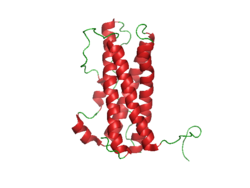Hypothalamic–pituitary–prolactin axis
 From Wikipedia the free encyclopedia
From Wikipedia the free encyclopedia

The hypothalamic–pituitary–prolactin axis (HPP axis), also known as the hypothalamic–pituitary–mammary axis or hypothalamic–pituitary–breast axis, is a hypothalamic–pituitary axis which includes the secretion of prolactin (PRL; luteotropin) from the lactotrophs of the pituitary gland into the circulation and the subsequent action of prolactin on tissues such as, particularly, the mammary glands or breasts.[1][2] It is involved in lobuloalveolar maturation of the mammary glands during pregnancy and the induction and maintenance of lactation following parturition.[3] Hormones that control the secretion of prolactin from the pituitary gland include dopamine ("prolactin-inhibiting factor", or "PIF"), estradiol, progesterone, thyrotropin-releasing hormone (TRH), and vasoactive intestinal peptide (VIP).[1][4]
See also
[edit]References
[edit]- ^ a b J. Larry Jameson (22 March 2013). Harrison's Endocrinology, 3E. McGraw Hill Professional. p. 16. ISBN 978-0-07-181487-4.
- ^ Puetz, Petra; Bellingrath, Silja; Gierens, Andrea; Hellhammer, Dirk H. (2010). "Neuroendocrine Measures in Behavioral Medicine". Handbook of Behavioral Medicine. pp. 659–670. doi:10.1007/978-0-387-09488-5_43. ISBN 978-0-387-09487-8.
- ^ Crowley WR (2015). "Neuroendocrine regulation of lactation and milk production". Compr Physiol. 5 (1): 255–91. doi:10.1002/cphy.c140029. ISBN 9780470650714. PMID 25589271.
- ^ Tony M. Plant; Anthony J. Zeleznik (15 November 2014). Knobil and Neill's Physiology of Reproduction. Academic Press. pp. 479–. ISBN 978-0-12-397769-4.